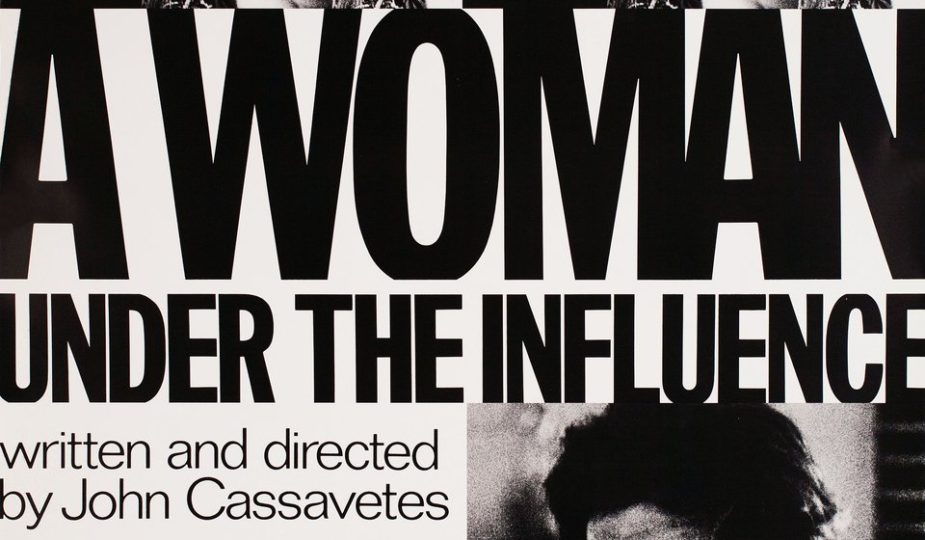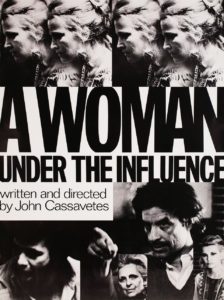
A Woman Under the Influence (1974)
A Woman Under the Influence is one of the most famous films directed by John Cassavetes, the father of American independent cinema. Cassavetes used to make his own films behind the back of the big industry and financed them with the earnings of his career as an actor. For this reason, he could afford to make a more difficult and risky type of cinema, since his proposals were absolutely unfeasible in Hollywood. His work usually dealt with crude and direct portrayals of human feelings and relationships between people. Above all, Cassavetes constantly avoided forced drama and aimed for a realism that focused on the little moments of everyday life.
The plot of A Woman Under The Influence is minuscule, Cassavetes places his main focus on the psychology of the characters and not in the structure of a traditional story. Nick Longhetti (Peter Falk) is a middle-aged construction worker who is married to Mabel (Gena Rowlands), a housewife with whom he has three young children: Angelo (Matthew Labyorteaux), Tony (Matthew Cassel) and Maria (Christina Grisanti). The main problems of the couple are the angry temperament of the man and the psychological volatility of the woman. Mabel suffers from a borderline personality disorder that leads her to behave in a very erratic and unsettling way. The starting point is Mabel’s mental instability, she is exposed as a woman with heavy ups and downs, accompanied by extravagant attitudes. She adores her husband and her children, and loves to host social gatherings. But in her continual attempts to be a good mother and wife, she causes violent and uncomfortable situations. Cassavetes is also concerned with creating a detailed portrait of Nick, a man who tries to have a balanced home but is unable to set an exemplary attitude. After Nick breaks his promise of spending an evening with his wife due to a work emergency, Mabel goes out and ends up having casual sex with a stranger that she met in a bar. The next morning, after working all night, Nick shows up at the house with his co-workers. They end up having a communal meal, in which Nick seems to test his wife’s ability to behave according to social conventions. It all results in an awkward moment due to Mabel’s obsession with one of the co-workers, and her insistence on dancing with all of them. Nick stops her with a loud yell that ends the meeting. Later, we see that Nick constantly mistreats Mabel, he is the stereotypical macho and tempered husband who loves his wife but loses his nerves too easily.
 Due to a series of events in which Mabel’s mental instability exacerbates, Nick decides to go with a trusted psychiatrist and friend of the troubled family, Doctor Zepp (Eddie Shaw). Finally, they decide to admit her in a psychiatric hospital. During his time alone as the head of the family, Nick tries to heal the children’s sadness, caused by the departure of their mother. However, Nick’s nervousness and lack of patience with the little ones becomes evident. Mabel is confined for six months, and Nick has the unfortunate idea of organizing a big party to welcome her back. However, he regrets this and throws everyone out at the last minute, leaving only the closest members of the family. When Mabel returns from the hospital, we discover that her joviality has disappeared. She has become a scared, cold and insecure woman. And that’s when Nick discovers that he loves the old, the real Mabel, even if she had that point of madness. Cassavetes, an expert in dissecting relationships and feelings between people, outlines here the great contradiction of marital relationships: you love and accept your partner’s personality, but at the same time you want to change or adapt him/her to your own tastes. Nick loves Mabel because of her strange personality, but he also wants to get rid off what is considered madness in her behaviour. But that’s not possible, because Mabel is largely defined by that.
Due to a series of events in which Mabel’s mental instability exacerbates, Nick decides to go with a trusted psychiatrist and friend of the troubled family, Doctor Zepp (Eddie Shaw). Finally, they decide to admit her in a psychiatric hospital. During his time alone as the head of the family, Nick tries to heal the children’s sadness, caused by the departure of their mother. However, Nick’s nervousness and lack of patience with the little ones becomes evident. Mabel is confined for six months, and Nick has the unfortunate idea of organizing a big party to welcome her back. However, he regrets this and throws everyone out at the last minute, leaving only the closest members of the family. When Mabel returns from the hospital, we discover that her joviality has disappeared. She has become a scared, cold and insecure woman. And that’s when Nick discovers that he loves the old, the real Mabel, even if she had that point of madness. Cassavetes, an expert in dissecting relationships and feelings between people, outlines here the great contradiction of marital relationships: you love and accept your partner’s personality, but at the same time you want to change or adapt him/her to your own tastes. Nick loves Mabel because of her strange personality, but he also wants to get rid off what is considered madness in her behaviour. But that’s not possible, because Mabel is largely defined by that.
Cassavetes’ style enriches the story with an outstanding level of realism. The audience sneaks into the main characters’ house and witness their personal miseries and conflicts. However, he completely flees away from melodrama and focuses on the little details. For example, we see nothing about the harsh therapy that Mabel faced in the hospital. This fact would be instantly highlighted in a conventional film, but the director is not interested in that. There are some scenes that would be solved immediately in most films, but Cassavetes stretches them until the point of reality: the meal with the workers that Nick invites to his house or the final party that celebrates the return of Mabel. These are long scenes in which apparently nothing happens, but the key is hidden in those trivial dialogues and silences. The closed camera shots make us empathize with the characters, we have the sensation of entering into their private worlds. This becomes evident when Mabel returns to the house after being admitted: she enters into the dining room and we expect that she’ll be greeted by her children. But instead of showing us the happy faces of the little ones, Cassavetes concentrates the scene in a close-up of Mabel falling into tears. This immediately results in a very intense and emotional scene. Mabel’s multiple close-up scenes with her children are unforgettable, since they exude an unprecedented purity that accentuates the feeling of intimacy.
As he already did and would continue to do throughout his filmography, Cassavetes sketched a crude, sincere and accurate portrait of human relationships with authentic realism. And as it happens in the real world, we don’t get a specific ending or a definitive answer to the problems. Mabel and Nick will continue together despite the fact that these conflicts are still present in their lives: life simply goes on.
by Ovctavio Carbajal González

What a great choice Octavio!!!!!!!
Woman Under the Influence is a movie that inspires hours of conversations.
Your review is insightful and you so well emphasize the incomparable realism that John Cassavetes uses to tell his stories.
The blurred lines of where scripted and improvisation meet are impossible to discern especially in this movie.
Inside the Longhetti household you see the stark realism of real people with real problems that don’t necessarily get a resolution. Conversations full of nuance and non sequiturs. Gena Rowlands gives an unequalled performance and Peter Falk masterful. I loved what you wrote about Mabel’s 6 months in the hospital and how a conventional film might have focussed more on it. Such a good point. I think that with Cassavetes anything that would deviate from his purpose would be inferred. John Cassavetes’ greatness only grows when people like you write with so much appreciation and understanding of his work. Another brilliant review Octavio.
What a pleasurable and kind comment. Thank you, Meg!.
I kind of went into this one blind, didn’t know what to expect. During the final minutes, a new door was unlocked. It was a challenging yet very rewarding experience for me.
Cassavetes’ realism makes every scene tenacious, and every word is filled with tension. As you said, the Longhetti household exudates a stark and conflictive atmosphere, it almost feels like we’re trapped inside a cage with spiky wires.
I would also highlight the special role of Mabel’s children… they are constantly experiencing wild swings (from love to hate to anger to laughter). Somehow, they feel the need to fix the chaos without truly understanding it. And Mabel thinks maybe the children can fix her, too.
All the praise to the acting roles of Rowlands and Falk, they indeed gave us performances that inspire hours of conversations.
A great choice Octavio!!!!!!!!!!!
Woman Under the Influence is a movie that inspires hours of conversations. Your review is insightful and you so well emphasize the incomparable realism that John Cassavetes uses to tell his stories.
The blurred lines of where scripted and improvisation meet are impossible to discern especially in this movie.
Inside the Longhetti household you see the stark realism of real people with real problems that don’t necessarily get a resolution. Conversations full of nuance and non sequiturs. Gena Rowlands gives an unequalled performance and Peter Falk masterful.
I loved what you wrote about Mabel’s 6 months in the hospital and how a conventional film might have focussed more on it. Such a good point. I think that with Cassavetes anything that would deviate from his purpose would be inferred. John Cassavetes’ greatness only grows when people like you write with so much appreciation and understanding of his work. Another brilliant review Octavio.
Octavio,
I think I might have viewed this film many years ago, but my memory of it is obscure so it is clear I need to revisit it. Thank You for your psychological, reflective review.
Let me know your thoughts when you revisit the film, there’s a whole bunch of interesting themes to discuss. Thank you, Mark.
One of the most thought-provoking and forcefully acted films that I’ve ever seen. It doesn’t feel dated almost 50 years later . Raw and visceral performances
I have an enormous respect for the films that stand the passage of time, this is definitely one of them
This is a film that hits close to home. Cassavetes beautifully depicts the deterioration of a woman’s mind. Capturing the highs and lows that Mabel faces with her progressing mental illness. Good job with the review
I totally respect the film’s faithfulness to Mabel’s downward spiral, but it can also be viewed as her cry for help against a patriarchal society, where it’s easy for men to blame “women under the influences”. Thanks for reading !
I struggle with Cassavetes and the end of this movie. I always thought it’s ridiculous and over-acted, the dialogues are cringe. And Peter Falk will always be Columbo to me, it destroys every part he plays.
I understand the divisive points about this film, but I definitely don’t share them.
Mental disorders, family dynamics and working class struggles are realistically portrayed here, very few films do that. I recommend you to watch more social-realist cinema and dig deeper into mental disorders, maybe that’ll change your perspective about this one.
Really great review Octavio and fantastic film choice. This is absolutely fascinating film and I don’t know who can play better Mabel’s role than brilliant Gena Rowlands. It’s great that you mentioned those two scenes (the meal with the workers and the final party), they are so original and skilfully directed. Like you said, nothong happens, but they are telling everything.
I just watched Cassavetes’s masterful Gloria, his wife Gena Rowlands is also there.
This was great start for 2022
Hey Mika, thanks for being an unconditional supporter of the page. I’m glad you liked my first article of the year.
This film is definitely a one of a kind experience. It gets very intimate, at times you feel like the intruder of the family’s privacy. I’ve only seen this kind of harsh realism in the films of Ken Loach and Mike Leigh.
Mabel is one of the most memorable characters in cinema’s history, hands down to Rowlands incredible interpretation. Those two scenes have all the keys that we need to understand the chaotic dynamics of the family. I haven’t seen Gloria, thanks for pointing it out !.
A breathtaking tornado of emotions, Rowlands is superb.
Very detailed review, so good!!
Thanks for reading, Adriana. Glad you liked it
This movie points at a crucial question : what is insanity, what is normal, and who defines that? The title is also interesting in that regard. Great, uncomfortable movie.
That’s right, Reiner. As film critic Roger Ebert said in his 4/4 stars review of this film:
“A Woman Under the Influence” gives us a woman whose influences only gradually reveal themselves. And as they do, they give us insights not only into one specific, brilliantly created, woman but into some of the problems of surviving in a society where very few people are fully liberated.
Fantastic review Octavio, I really enjoyed this. One of my favorite directors with one of his best films. Geena Rowlands and Peter Falk are great. Authenticity and vulnerability were Cassavetes themes, such a hard-hitting, driven man bursting with passion and energy. I’m loving his performances. I recently rewatched him in that brilliant Columbo episode, Etude in Black. I love Cassavetes very own existential rat pack with Falk and Gazzarra. Priceless director, one of a kind.
Thanks for covering this, existential start into the new year
An honor to be the one that opens with this 2022, thank you Saliha.
This is a very special film, we have a realistic combination of a woman’s downward spiral and a humanist deconstruction of acceptable social politics. It encompasses family, commitment, despair, endurance and the struggles of the working class. Agree with you, authenticity and vulnerability were the pillars that sustained Cassavetes’ style.
“Love Streams”, “Faces” and “Husbands” also occupy a bright spot in my film catalogue, but “A Woman Under the Influence” belongs to a shiny peak of greatness. I’ll never forget the goosebumps-inducing acting from Rowlands and Falk… By the way, need to check out that Columbo episode, I’ve seen good reviews about it.
It was a pleasure to cover this one !